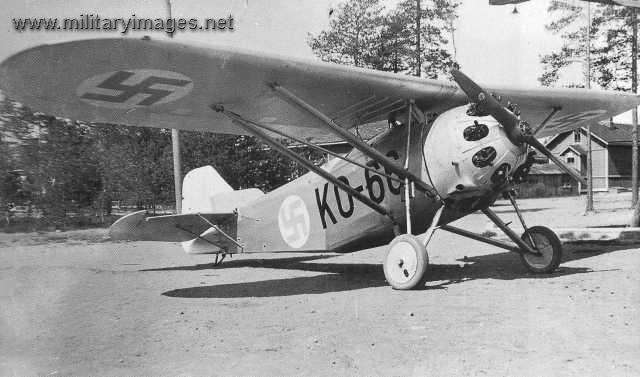Thx for the info and the photos

1st installment - on Ilmailuvoimien Lentokonetehdas / the Finnish Airforce Aircraft Factory - how does this look as a summary (not trying to write the book here, just provide a good accurate overview)
Ilmailuvoimien Lentokonetehdas / the Finnish Airforce Aircraft Factory)
Valtion Lentokonetehdas or VL as it was more commonly referred to, started life as IVL (Ilmailuvoimien Lentokonetehdas / the Finnish Airforce Aircraft Factory) founded in 1921. But the starting point had actually been a little earlier – in the Civil War, the Russian military airport near Turku had been captured by the Finnish White Army and in late 1918, repairs to aircraft and aircraft engines belonging to the nacent Ilmavoimat were made there. In the autumn of 1919 the repairshop was transferred to Santahamina military base (in Helsinki) and renamed "Ilmailutelakka" (literally: Aero Dockyard), and was made a unit of the “Ilmailupataljoona” (Aero Battalion) which was then later renamed “Lentopataljoona” (Flight Battalion). This "dockyard" took care of repairing aircraft and their engines and was, as the name illustrates, a seaplane base.A separate aircraft factory got under way in 1920 amd in May of 1920 Ilmailuvoimien Lentokonetehdas (usually abbreviated to IVL or I.V.L) existed alongside the "Aero Dockyard."
IVL had begun its production at Suomenlinna and Santahamina in Helsinki, with the Suomenlinna location being used for new aircraft construction and Santahamina being used as the repair base for aircraft and engines. The early aircraft factory did not have an airport, only the sea and sea ice could be used for take-off and landing as most of the aircraft built in Helsinki were seaplanes. The aircraft built were small and much of the final assembly was done outdoors. IVL’s first managing director was Luutnantti (Lt) Asser Järvinen who had studied aircraft building in France, which at that time was one of the best sources of aviation expertise, for a short period.
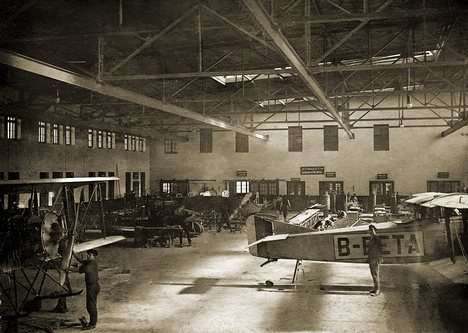 Ilmavoimien Lentokonetehdas factory, IVL – late 1920’s
Ilmavoimien Lentokonetehdas factory, IVL – late 1920’s
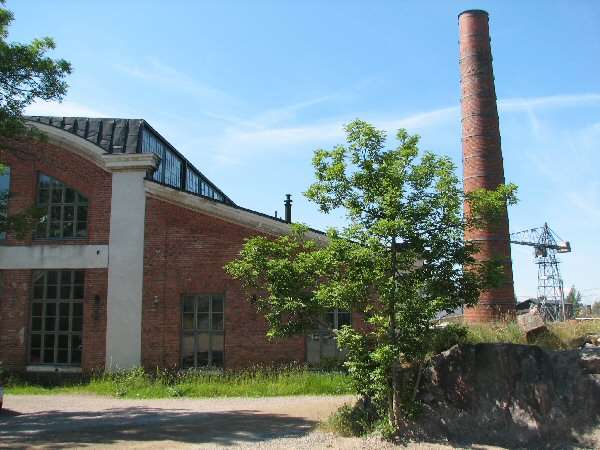 Two photos of the exterior of the old aircraft factory building, this was the factory building of Ilmavoimien Lentokonetehdas from 1921 - 1928 and Valtion Lentokonetehdas from 1928 - 1936. Photos taken by Jarkko in Suomenlinna in 2010 (photo courtesy of http://www.jaegerplatoon.net).
Two photos of the exterior of the old aircraft factory building, this was the factory building of Ilmavoimien Lentokonetehdas from 1921 - 1928 and Valtion Lentokonetehdas from 1928 - 1936. Photos taken by Jarkko in Suomenlinna in 2010 (photo courtesy of http://www.jaegerplatoon.net).
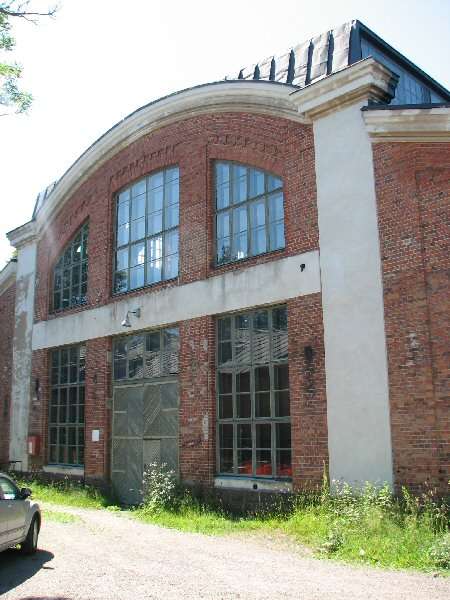 Two photos of the exterior of the old aircraft factory building, this was the factory building of Ilmavoimien Lentokonetehdas from 1921 - 1928 and Valtion Lentokonetehdas from 1928 - 1936. Photos taken by Jarkko in Suomenlinna in 2010 (photo courtesy of http://www.jaegerplatoon.net).
Two photos of the exterior of the old aircraft factory building, this was the factory building of Ilmavoimien Lentokonetehdas from 1921 - 1928 and Valtion Lentokonetehdas from 1928 - 1936. Photos taken by Jarkko in Suomenlinna in 2010 (photo courtesy of http://www.jaegerplatoon.net).
The first aircraft to be built by IVL were the Hansa-Brandenburg aircraft mentioned in an earlier post on the Ilmavoimat – in 1921 Finland had obtained the manufacturing license for the Hansa-Brandenburg W.33. The first Finnish IVL -built Hansa made its maiden flight on November 4, 1922 and was in Finland was designated the IVL A.22 Hansa. This aircraft was the first industrially manufactured aircraft in Finland and over the following four years a total of 120 of the aircraft were manufactured. This aircraft would become the second most numerous aircraft built in Finland for the Finnish Air Force. With the purchase of the license to build the Hansa-Brandenburgs, six Germans came to work in the Suomenlinna factory, where they were supported by 12 Finnish mechanics and carpenters. G. Semeniuksen managed the factory and G. Jäderholm was the test pilot.
The IVL A.22 Hansa was a Finnish-licensed copy of the German Hansa-Brandenburg W.33, a two-seat, singe-engined low-winged monoplane flying boat. The Hansa-Brandenburg W.33 was designed in 1916 by Ernst Heinkel and entered German service in 1918. Twenty-six aircraft of this design were built in Germany, only six of them before the collapse of Germany. The W.33 proved to be an excellent aircraft, with the Hansa-Brandenburg monoplanes considerably influencing German seaplane design. Several copies appeared in 1918, such as the Friedrichshafen FF.63, the Dornier Cs-I, the Junkers J.11, and the L.F.G. Roland ME 8. After the war a version of the W.29 was also used by Denmark.
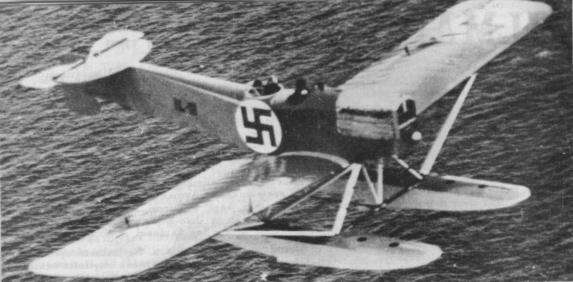 Hansa-Brandenburg. Technical information: Wooden construction, two-seat sea plane. Weight 2124 kg, Max speed 170 km/h (99mph), wingspan 15.85 m, length 11.10 m, endurance 6 hours. Weapons: navigator's twin machine gun, bombs 4x10 kg. It had good flight characteristics, but its gross weight tended to increase with age due to water soaking, which led to problems in calm weather takeoffs.
Of Note:
Hansa-Brandenburg. Technical information: Wooden construction, two-seat sea plane. Weight 2124 kg, Max speed 170 km/h (99mph), wingspan 15.85 m, length 11.10 m, endurance 6 hours. Weapons: navigator's twin machine gun, bombs 4x10 kg. It had good flight characteristics, but its gross weight tended to increase with age due to water soaking, which led to problems in calm weather takeoffs.
Of Note: The Finnish Broadcasting Company Yle has been transferring it's archives to the internet and one of the videos is about the Finnish Air Force Airshow in 1926. The plane in the film is 4F66 which was the 66th Hansa build in Finland. It was taken into service in 20th December 1924. To see the video click the link and press "play" below the image and next to "armeijan lentonäytös". If you have enough bandwidth you can choose bigger image by pressing "play" and then select "asetukset" from right hand top corner and then select "1 Mbps tai nopeampi" and "tallenna asetukset".
http://www.yle.fi/elavaarkisto/?s=s&g=1&ag=1&t=&a=47
A new, longer version of this film has also been published. More Hansa’s and a Breguet 14. Use this link.
http://www.yle.fi/elavaarkisto/?s=s&g=1&ag=1&a=2306
The Santahamina factory also built six Caudron G.3 Aircraft under license between 1920 and 1924 (incidentally, construction of the Caudron G.3’s started prior to the Hansa-Brandenburgs ). 12 had been bought from France, six were built in Finland by the newly established Santahaminan Ilmailutelakka and two aircraft and spares were purchased from Flyg Aktiebolaget on April 26, 1923 together with a Caudron G.4 for 100,000 Finnish markka. The Finnish-constructed aircraft had worse flying characteristics than the French machines due to a bad wing profile. The FAF used a total of 19 Caudron G.3 aircraft, which was called Tutankhamon in Finland. The Caudron G.3 was used by the FAF between 1920 and 1924.
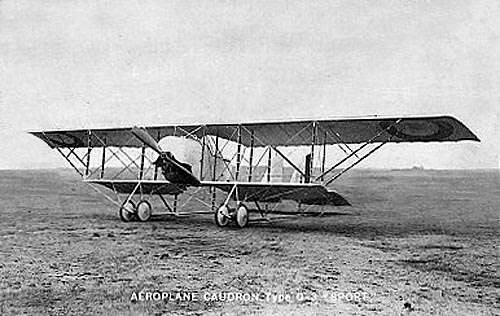 The Caudron G.3 was a single-engined French biplane built by Caudron, widely used in World War I as a reconnaissance aircraft and trainer. It first flew in May 1914 at their Le Crotoy aerodrome. The aircraft had a short crew nacelle, with a single engine in the nose of the nacelle, and twin open tailbooms. It was of sesquiplane layout, and used wing warping for lateral control, although this was replaced by conventional ailerons fitted on the upper wing in late production aircraft. Following the outbreak of the First World War, it was ordered in large quantities. Usually, the G.3 was not equipped with any weapons, although sometimes light, small calibre machine guns and some hand-released small bombs were fitted to it. It continued in use as a trainer after ceasing combat operations until after the end of the war. One aircraft (1E.18) is currently being repaired at the Hallinportti Aviation Museum.
The Caudron G.3 was a single-engined French biplane built by Caudron, widely used in World War I as a reconnaissance aircraft and trainer. It first flew in May 1914 at their Le Crotoy aerodrome. The aircraft had a short crew nacelle, with a single engine in the nose of the nacelle, and twin open tailbooms. It was of sesquiplane layout, and used wing warping for lateral control, although this was replaced by conventional ailerons fitted on the upper wing in late production aircraft. Following the outbreak of the First World War, it was ordered in large quantities. Usually, the G.3 was not equipped with any weapons, although sometimes light, small calibre machine guns and some hand-released small bombs were fitted to it. It continued in use as a trainer after ceasing combat operations until after the end of the war. One aircraft (1E.18) is currently being repaired at the Hallinportti Aviation Museum.
In 1922, the company hired an engineer, K W Berger, who had studied in London. He first designed an improved propeller for the Hansa Brandenburg and then went on to design the C.24 (1924), C.VI.25 (1925) and Haukka I (1927) - only a single prototype of each was built. In 1928 two prototypes of the Haukka II were built. None of these aircraft were mass-produced and only the Haukka could be said to be a successful design. In 1928 a prototype of Berger’s Sääski design was tested and the aircraft was then mass produced as a Trainer. Berger then designed the Kotka – a two-seat, biplane maritime patrol aircraft meant to replace the Blackburn Ripons that were in service with the Finnish Air Force. A prototype made its first flight on September 30, 1930. In 1931 the State Aircraft Factory began producing a series of five aircraft. These were used as liaison aircraft until 1944. Berger also participated in decisions of the Finnish Air Force on the purchases of foreign fighters from Czechoslovakia, Great Britain, the Netherlands, Italy and France in the late 1920s and early 1930s. Berger was dismissed from his position at VL during a company restructuring in 1933.
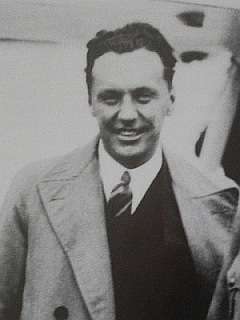 Kurt Volmar Berger (1896–1977) was an aviation engineer and the chief designer at the Finnish aircraft manufacturing company Valtion Lentokonetehtaat for a number of years. K. V. Berger's father, Arnold Berger, was a minister and his mother was Fanny Berger. He became a student at Helsingin Uusi Yhteiskoulu in 1916 and studied as an electrical engineer at the Helsinki University of Technology starting the same autumn, but then volunteered for service with the Jaegers. In 1918 he traveled to Libau in Germany, where he started pilot training on float-equipped aircraft. However, his pilot training was interrupted by the end of World War I and by Germany losing the war. In the end, Berger managed to receive his international civil pilot papers in 1921. In order to continue with his studies, he enrolled at the East London College in 1919 (nowadays called Queen Mary School, University of London), graduating on 5 September 1922.
Kurt Volmar Berger (1896–1977) was an aviation engineer and the chief designer at the Finnish aircraft manufacturing company Valtion Lentokonetehtaat for a number of years. K. V. Berger's father, Arnold Berger, was a minister and his mother was Fanny Berger. He became a student at Helsingin Uusi Yhteiskoulu in 1916 and studied as an electrical engineer at the Helsinki University of Technology starting the same autumn, but then volunteered for service with the Jaegers. In 1918 he traveled to Libau in Germany, where he started pilot training on float-equipped aircraft. However, his pilot training was interrupted by the end of World War I and by Germany losing the war. In the end, Berger managed to receive his international civil pilot papers in 1921. In order to continue with his studies, he enrolled at the East London College in 1919 (nowadays called Queen Mary School, University of London), graduating on 5 September 1922.
He was appointed Engineer at the Finnish Air Force Headquarters at Santahamina on 1 November 1923, and later Chief Engineer in 1 March 1924. He was then sent to the Finnish Air Force Aircraft Manufacturing company (Ilmavoimien Lentokonetehdas) where he went on to design the IVL C.24, IVL Haukka I, IVL Haukka II, IVL Sääski and the IVL Kotka aircraft. Berger also participated in decisions of the Finnish Air Force on the purchases of foreign fighters from Czechoslovakia, Great Britain, Italy and France in the late 1920s and early 1930s. Berger was dismissed from his position at VL during a company restructuring in 1933. He continued to work as aircraft inspector at Lentoasema I and Flight Regiment 2. During the Soviet-Finnish Winter War of 1939–40 he supervised the assembly of the Brewster Buffalo fighters in Sweden, as well as served as Chief Engineer of Maintenance and Office Engineer at Finnish Air Force Headquarters. After WW2 he continued in business as a private entrepreneur.
The Ilmavoimat had also purchased 30 Caudron C.60s from France in 1923. A further 34 aircraft were licence built in Finland between 1927 and 1928. These were used as primary trainers until 1936, when they were retired as more modern trainers were brought into service. With a maximum speed of 93mph, a ceiling of 13,120 feet and an endurance of 5 hours, they were a typical biplane trainer of the 1920’s.
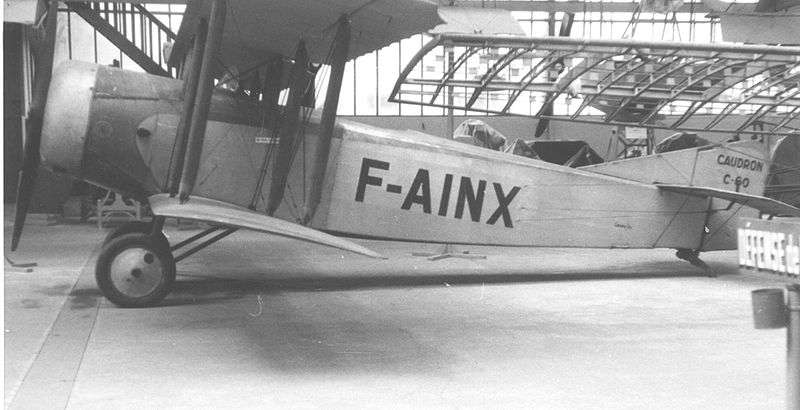 Caudron C.60 Trainer
Caudron C.60 Trainer
In 1924, IVL built a prototype of the Berger-designed C.24. The IVL C.24 was the first aircraft to be completely designed and built from the ground up in Finland but only one example of the aircraft was manufactured by IVL. The aircraft made its maiden flight on April 16, 1924, piloted by Georg Jäderholm. The aircraft was a single-seater, high-wing monoplane and was designed as a fighter. However, the selected birotary engine was underpowered and proved a complete failure, spelling the doom of the project. Worse, flight characteristics were poor and the visibility from the pilot's seat was also very poor. The aircraft was in Finnish Air Force use for a short time as a prototype only.
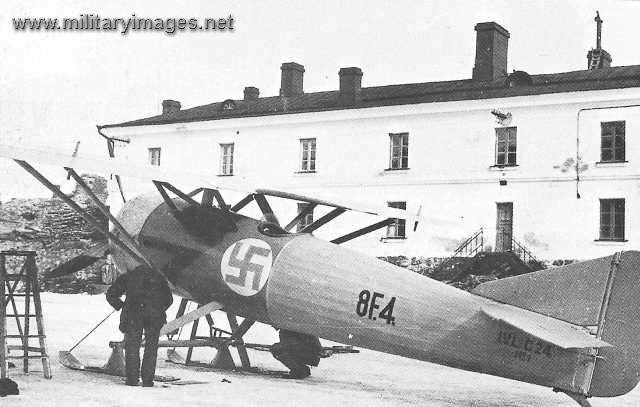 IVL C.24 at Suomenlinna in the Spring of 1924.
IVL C.24 at Suomenlinna in the Spring of 1924.
The IVL C.VI.25 was further development of the IVL C.24. Designed by Berger as a fighter, the aircraft made its maiden flight on June 11, 1925 and was wrecked after a forced landing due to engine trouble on December 17, 1925. The aircraft was under-powered like its predecessor, due to the choice of the same cheap but useless engine as used in its predecessor and it was not considered worthwhile to carry out further development.
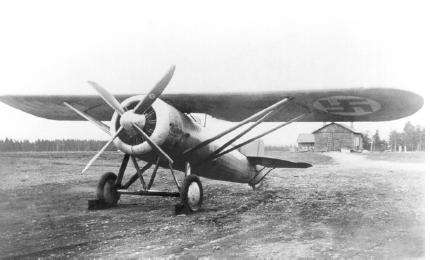 The IVL C.VI.25
The IVL C.VI.25
In 1927 Ilmailuvoimien Lentokonetehdas built a prototype of the K.1 Kurki (“Crane”) – designed by Asser Järvinen, this was intended as a four-seated, high-wing trainer aircraft. The prototype was manufactured at the IVL plant at Suomenlinna and made its maiden flight on March 30, 1927. The aircraft was both over weight and too front-heavy. It also had poor flight characteristics. The Finnish Air Force only flew the aircraft 13 hours. No development potential was seen for the overweight "Järvinen's crate", and work on the project was terminated. Only one aircraft was manufactured (the Päijät-Häme Aviation Museum has stored the only Kurki manufactured).
 I.V.L K.1 Kurki
I.V.L K.1 Kurki
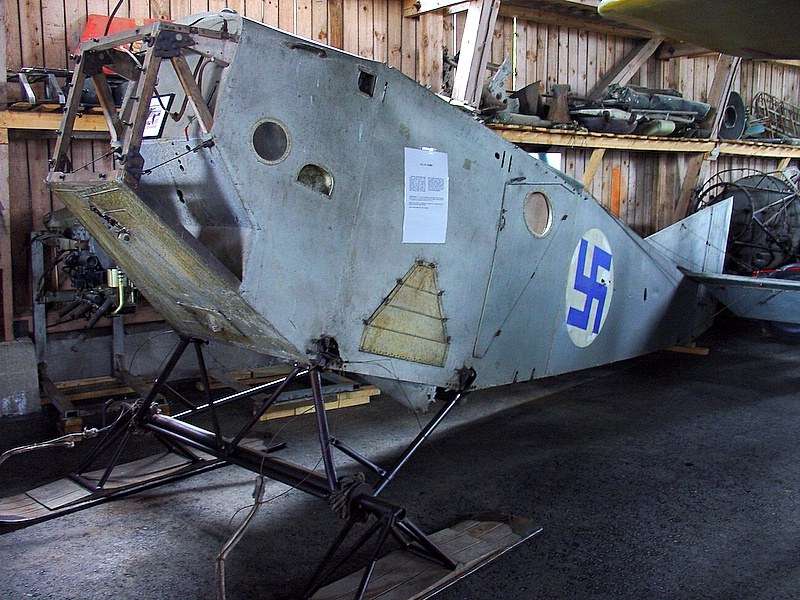 The remains of the only K.1 Kurki in existence - Päijät-Häme Aviation Museum
The remains of the only K.1 Kurki in existence - Päijät-Häme Aviation Museum
Overall, aircraft built under the auspices of Ilmailuvoimien Lentokonetehdas included:
Caudron G.3 – 6 built under license
IVL A.22 Hansa-Brandenburg W.33 – 120 built under license
IVL C.24 (protype only)
IVL C.25 (prototype only)
Caudron C.60 – 34 built under license
IVL D.26 Haukka I (prototype only)
IVL K1. Kurki (prototype only)
Valtion Lentokonetehdas or VL as it was more commonly referred to, was founded on 23 February 1928 from I.V.L (the Finnish Airforce Aircraft Factory), at which time the company was transferred from the Ilmavoimat to the Ministry of Defence.
Next Post: Valtion Lentokonetehdas
And if anyone has any photos of, and information on, Georg Jäderholm and Asser Järvinen that they could post, that would be appreciated. Also any photos of the aircraft actually being built?
Kiitos..........Nigel














